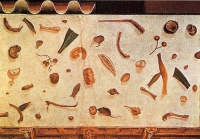The Unswept Floor
From The Art and Popular Culture Encyclopedia
|
Related e |
|
Featured: |
"The Unswept Floor" is a now lost mosaic by the 2nd-century BC mosaicist Sosus of Pergamon. As described by Pliny, it is a floor mosaic which depicted the leftovers of a meal on a floor.
Pliny mentions this trompe l'oeil (optical illusion) in his Natural History (XXXVI, 184):
- "[Sosos] laid at Pergamon what is called the asarotos oikos or 'unswept room,' because on the pavement was represented the debris of a meal, and those things which are normally swept away, as if they had been left there, made of small tessera of many colours."
Apparantly, trompe l'oeil debris was a moderately popular Hellenistic and Roman mosaic theme for dining room floors.
There are quite a few Roman mosaics depicting the remnants of a banquet.
Heraklitos copy
In the second century AD, a certain Herakleitos makes a copy of The Unswept Floor original by Sosus of Pergamon. The mosaic bears the signature of the artist Heraclitus, “ΗΡΑΚΛΙΤΟΣ ΗΡΓΑΣΑΤΟ”. The Herakleitos copy, discovered in 1833 at Vigna Lupi on the Aventine Hill, is now kept at Vatican Museums. The mosaic is also referred to as the "Mosaico della Vigna Lupi" and is also related to a certain 'C. Bunsen'. The mosaic depicts "shadowed lobster legs, leaves, and nuts (even a mouse) are all littered against a plain background of very small tesserae (opus vermiculatum)."[1]
- In this copy, chicken bones, seashells, fish bones, lobster’s pincers, sea urchins, fruits etc are depicted, scattered on the surface. The realism of the morphology of the objects (but not their proportions), the consistency in shading, the similarity of the theme (e.g. the unswept floor) and the spatial setting of the mosaic, contribute to the creation of a scene with optical illusion effects (trompe l'œil). Moreover, the depiction of a mouse enriches the scene with a narrative element, enhances its realistic character and functions as a surprising, “scary” detail, which gives a playful tone to the representation.[2]
Boudry
In Boudry, Switzerland, at the Château de Boudry, there is another example of a asarotos oikos
- En dépôt au Musée, cette somptueuse mosaïque représente une scène de banquet, comprenant neuf personnages couchés sur un lit en demi-cercle appelé stibadum ou lit en sigma. Servis par sept serviteurs, les convives reposent tous sur leur côté gauche, selon l'usage romain du symposium,autrement dit du banquet. Le repas est déjà bien avancé, comme l'indiquent les nombreux restes de nourriture éparpillés sur le sol, ainsi que la tenue des convives, décrits plus ou moins déshabillés et ivres. Le banquet a lieu dans le triclinum, la salle à manger romaine, qui se caractérise par les tentures cachant les entrées et les fenêtres et la disposition des lits de banquet arrangés autour d'une table centrale.
See also
- Another example of the 'asarotos oikos' is at Museo archeologico nazionale di Aquileia.
- Triclinium
- Hellenistic art
- Oikos
- Roman mosaics
- Sweeping


